Integrating Bayesian Networks and Numerical Simulation for Risk Assessment of Deep Foundation Pit Clusters
Abstract
1. Introduction
2. Risk Assessment Framework for DFPCs
2.1. Risk Decomposition of DFPCs and Construction of the Fault Tree
2.2. Optimizing the Bayesian Network via Structural Learning
2.3. Probability of Risk Occurrence
3. Case Study
3.1. Demonstration of Deep Foundation Pit Simulation
3.2. Simulation of Support Failure in a Single Foundation Pit
3.3. Evaluation of Support Failure in Deep Foundation Pit Clusters (DFPCs)
4. Conclusions
Author Contributions
Funding
Data Availability Statement
Conflicts of Interest
References
- Tan, Y.; Wang, D.; Lu, Y.; Fang, T. Excavation of middle Huai-Hai road station of Shanghai metro line 13: Challenges, risks, countermeasures, and performance assessment. Pract. Period. Struct. Des. Constr. 2017, 22, 05017003. [Google Scholar] [CrossRef]
- Lin, S.S.; Zhou, A.; Shen, S.L. Multi-status Bayesian network for analyzing collapse risk of excavation construction. Autom. Constr. 2024, 158, 105193. [Google Scholar] [CrossRef]
- Zhang, K.; Li, J. Accident analysis for 08.11.15 foundation pit collapse of Xianghu station of Hangzhou metro. Chin. J. Geot. Eng. 2010, 32, 338–342. [Google Scholar]
- Li, F.; Phoon, K.K.; Du, X.; Zhang, M. Improved AHP method and its application in risk identification. J. Constr. Eng. Manage. 2013, 139, 312–320. [Google Scholar] [CrossRef]
- Lin, S.S.; Shen, S.L.; Zhou, A.; Xu, Y.S. Risk assessment and management of excavation system based on fuzzy set theory and machine learning methods. Autom Constr. 2021, 122, 103490. [Google Scholar] [CrossRef]
- Zhou, H.B.; Zhang, H. Risk assessment methodology for a deep foundation pit construction project in Shanghai, China. J. Constr. Eng. Manag. 2011, 137, 1185–1194. [Google Scholar] [CrossRef]
- Wei, D.; Xu, D.; Zhang, Y. A fuzzy evidential reasoning-based approach for risk assessment of deep foundation pit. Tunn. Undergr. Space Technol. 2020, 97, 103232. [Google Scholar] [CrossRef]
- Abdelgawad, M.; Fayek, A.R. Risk management in the construction industry using combined fuzzy FMEA and fuzzy AHP. J. Constr. Eng. Manag. 2010, 136, 1028–1036. [Google Scholar] [CrossRef]
- Kwast-Kotlarek, U.; Hełdak, M. Evaluation of the construction and investment process of a high-pressure gas pipeline with use of the trenchless method and open excavation method. Analytic hierarchy process (AHP). Sustainability 2019, 11, 2438. [Google Scholar] [CrossRef]
- Boulaid, G.; Bahi, L.; Ouadif, L. Risk assessment of excavation work of different types of construction projects using AHP. Int. J. Civ. Eng. Technol. 2018, 9, 861–870. [Google Scholar]
- Koulinas, G.K.; Marhavilas, P.K.; Demesouka, O.E.; Vavatsikos, A.P.; Koulouriotis, D.E. Risk analysis and assessment in the worksites using the fuzzy-analytical hierarchy process and a quantitative technique–A case study for the Greek construction sector. Saf. Sci. 2019, 112, 96–104. [Google Scholar] [CrossRef]
- Soltanzadeh, A.; Mahdinia, M.; Jafarinia, E.; Golmohammadpour, H.; Sadeghi-Yarandi, M. Occupational safety risk analysis in construction sites based on fuzzy analytic hierarchy process: A case study in a large construction project. Work 2023, 76, 771–782. [Google Scholar] [CrossRef]
- Cheng, M.; Lu, Y. Developing a risk assessment method for complex pipe jacking construction projects. Autom Constr. 2015, 58, 48–59. [Google Scholar] [CrossRef]
- Xun, T. Risk assessment of foundation pit construction using cloud model. In E3S Web of Conferences; EDP Sciences: London, UK, 2020; Volume 165, p. 04070. [Google Scholar] [CrossRef]
- Zhang, W.; Huang, Z.; Zhang, J.; Zhang, R.; Ma, S. Multifactor uncertainty analysis of construction risk for deep foundation pits. Appl. Sci. 2022, 12, 8122. [Google Scholar] [CrossRef]
- Wu, J.; Gong, H.; Liu, F.; Liu, Y. Risk assessment of open-pit slope based on large-scale group decision-making method considering non-cooperative behavior. Int. J. Fuzzy Syst. 2023, 25, 245–263. [Google Scholar] [CrossRef]
- Zhou, Y.; Li, S.; Zhou, C.; Luo, H. Intelligent approach based on random forest for safety risk prediction of deep foundation pit in subway stations. J. Comput. Civ. Eng. 2019, 33, 05018004. [Google Scholar] [CrossRef]
- Xiudong, X.; Caizhen, P. Safety prediction of deep foundation pit based on neural network and entropy fuzzy evaluation. In E3S Web of Conferences; EDP Sciences: London, UK, 2021; Volume 233, p. 03001. [Google Scholar] [CrossRef]
- Hong, C.; Luo, G.; Chen, W. Safety analysis of a deep foundation ditch using deep learning methods. Gondw. Res. 2023, 123, 16–26. [Google Scholar] [CrossRef]
- Uge, B.U.; Guo, Y. Deep foundation pit excavations adjacent to disconnected piled rafts: A review on risk control practice. Open J. Civ. Eng. 2020, 10, 270. [Google Scholar] [CrossRef]
- Kang, J.; Wan, D.; Sheng, Q.; Fu, X.; Pang, X.; Xia, L.; Li, D. Risk assessment and support design optimization of a high slope in an open pit mine using the jointed finite element method and discontinuous deformation analysis. Bull. Eng. Geol. Environ. 2022, 81, 254. [Google Scholar] [CrossRef]
- Ge, C.; Yang, M.; Li, P.; Zhang, M. Influence of deep foundation pit excavation on surrounding environment: A case study in Nanjing, China. Acta Geophysa. 2025, 73, 495–516. [Google Scholar] [CrossRef]
- Sousa, R.L.; Einstein, H.H. Risk analysis during tunnel construction using Bayesian Networks: Porto Metro case study. Tunn. Undergr. Space Technol. 2012, 27, 86–100. [Google Scholar] [CrossRef]
- Wang, Z.Z.; Chen, C. Fuzzy comprehensive Bayesian network-based safety risk assessment for metro construction projects. Tunn. Undergr. Space Technol. 2017, 70, 330–342. [Google Scholar] [CrossRef]
- Ruiz-Tagle, A.; Lopez Droguett, E.; Groth, K.M. Exploiting the capabilities of Bayesian networks for engineering risk assessment: Causal reasoning through interventions. Risk Anal. 2022, 42, 1306–1324. [Google Scholar] [CrossRef]
- Schell, C.A.; Ruiz-Tagle, A.; Lewis, A.D.; Katrina, M.G.; Construction and Verification of a Bayesian Network for Third-Party Excavation Risk Assessment (BaNTERA). Probabilistic Safety Assessment and Management (PSAM16). 2022. Available online: https://drum.lib.umd.edu/items/51bd52bf-bbca-42a6-8cbd-2df1a35b5bc6 (accessed on 2 July 2025).
- Hassan, S.; Wang, J.; Kontovas, C.; Bashir, M. An assessment of causes and failure likelihood of cross-country pipelines under uncertainty using bayesian networks. Reliab. Eng. Syst. Saf. 2022, 218, 108171. [Google Scholar] [CrossRef]
- Goh, A.T.C.; Fan, Z.; Hanlong, L.; Wengang, Z.; Dong, Z. Numerical analysis on strut responses due to one-strut failure for braced excavation in clays. In Proceedings of the 2nd International Symposium on Asia Urban Geoengineering, Changsha, China, 24–27 November 2017; Springer: Berlin/Heidelberg, Germany, 2018; pp. 560–574. [Google Scholar] [CrossRef]
- Lei, H.; Zhan, B.; Feng, S.; Amin, M. Influence of Foundation pit groups’ excavation on the deformation characteristics of adjacent railway Subgrade and Protection measures. Geotech. Geol. Eng. 2023, 41, 3877–3895. [Google Scholar] [CrossRef]
- Constantinou, A.C.; Liu, Y.; Chobtham, K.; Guo, Z.; Kitson, N.K. Large-scale empirical validation of Bayesian Network structure learning algorithms with noisy data. Int. J. Approx. Reason. 2021, 131, 151–188. [Google Scholar] [CrossRef]
- Kitson, N.K.; Constantinou, A.C.; Guo, Z.; Liu, Y.; Chobtham, K. A survey of Bayesian Network structure learning. Artif. Intell. Rev. 2023, 56, 8721–8814. [Google Scholar] [CrossRef]
- Solomon, T.; Soh, L.K.; Dodd, M.D.; Esmaeili, B. Variables influencing change blindness in construction safety. Saf. Sci. 2025, 184, 106761. [Google Scholar] [CrossRef]
- Ouaissa, M.; Laidi, M.; Benkortbi, O.; Maarof, H. QSPR modeling to predict surface tension of psychoanaleptic drugs using the hybrid DA-SVR algorithm. J. Mol. Graph. Model. 2025, 134, 108896. [Google Scholar] [CrossRef]
- Aminbakhsh, S.; Gunduz, M.; Sonmez, R. Safety risk assessment using analytic hierarchy process (AHP) during planning and budgeting of construction projects. J. Saf. Res. 2013, 46, 99–105. [Google Scholar] [CrossRef]
- Zheng, G.; Zhao, J.; Cheng, X.; Yu, D.Y.; Wang, R.Z.; Zhu, X.W.; Yi, F. Mechanism and control measures of the vertical progressive collapse of deep excavations retained by a multilayer strutting system. J. Tianjin Univ. Sci. Technol. 2021, 54, 1025–1038. [Google Scholar]
- Cheng, X.; Pei, H.; Yi, F.; Zheng, G.; Zhang, Y.; Ma, Y.; Wang, S. Study on the mechanism and countermeasures of progressive collapse in deep excavation retained by multilayer struts. Structures 2024, 60, 105837. [Google Scholar] [CrossRef]
- Zucca, M.; Franchi, A.; Crespi, P.; Longarini, N. The new foundation system for the transept reconstruction of the basilica di collemaggio. In Proceedings of the International Masonry Society Conferences, Milan, Italy, 9–11 July 2018; pp. 9–11. [Google Scholar]
- Li, L.; Sun, Q.; Wang, Y.; Gao, Y. A data-driven indirect approach for predicting the response of existing structures induced by adjacent excavation. Appl. Sci. 2023, 13, 3826. [Google Scholar] [CrossRef]
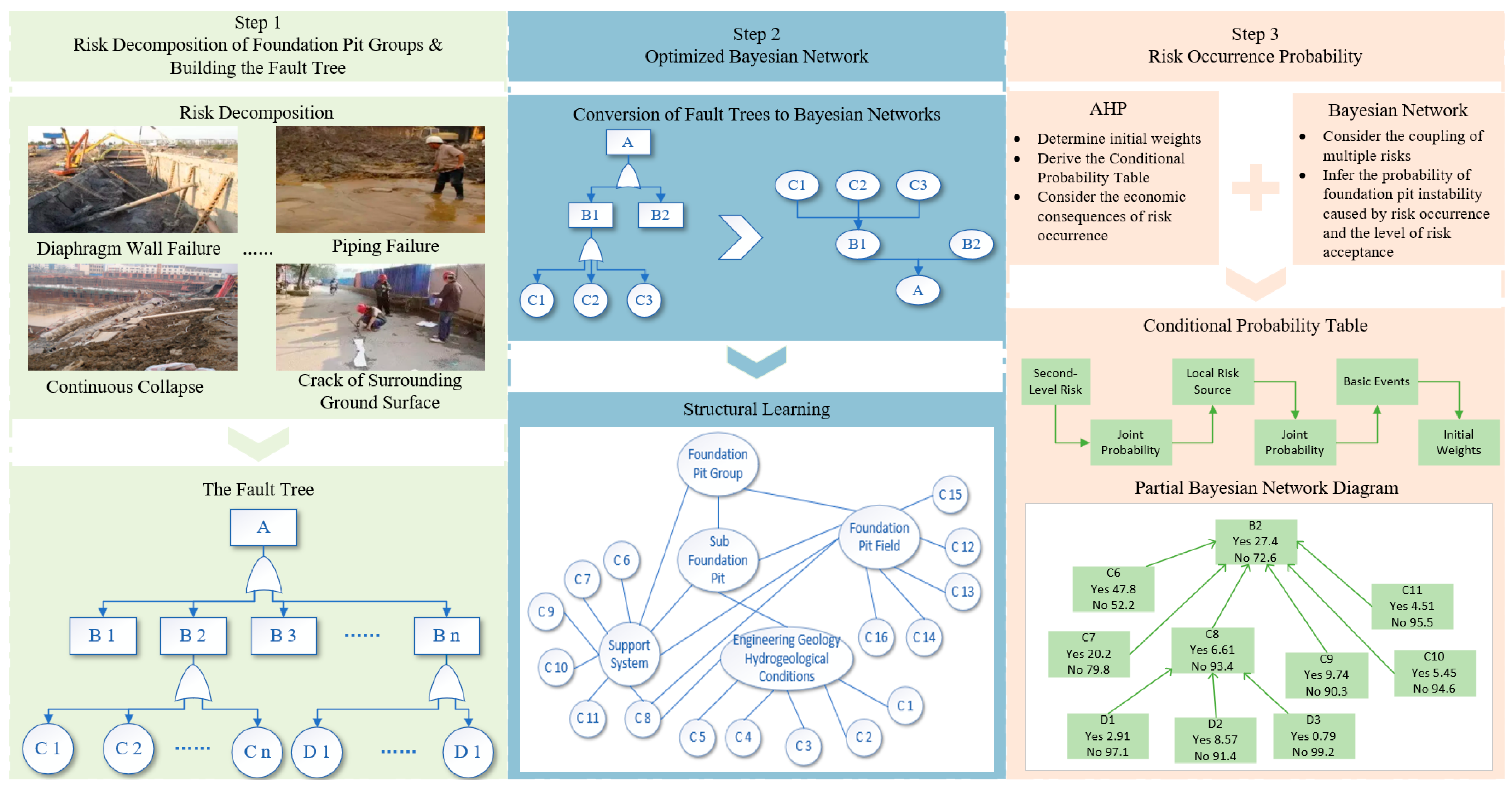
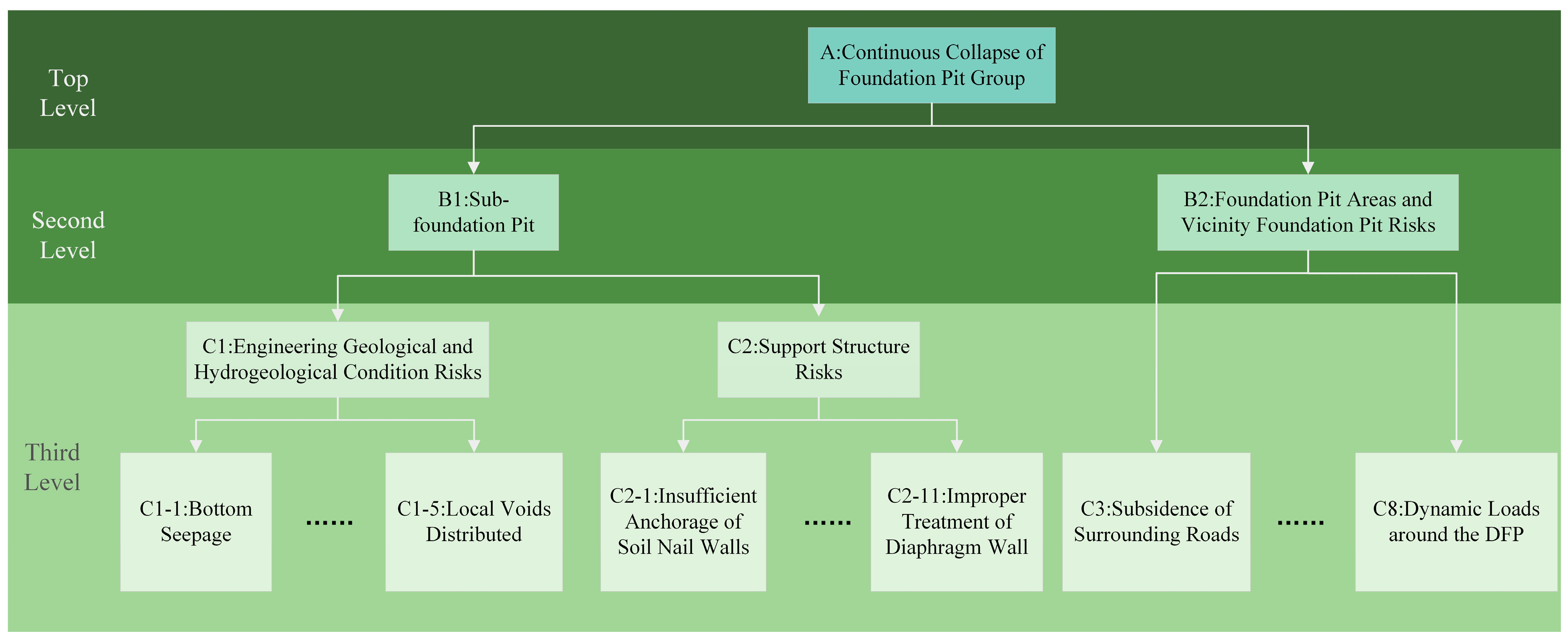
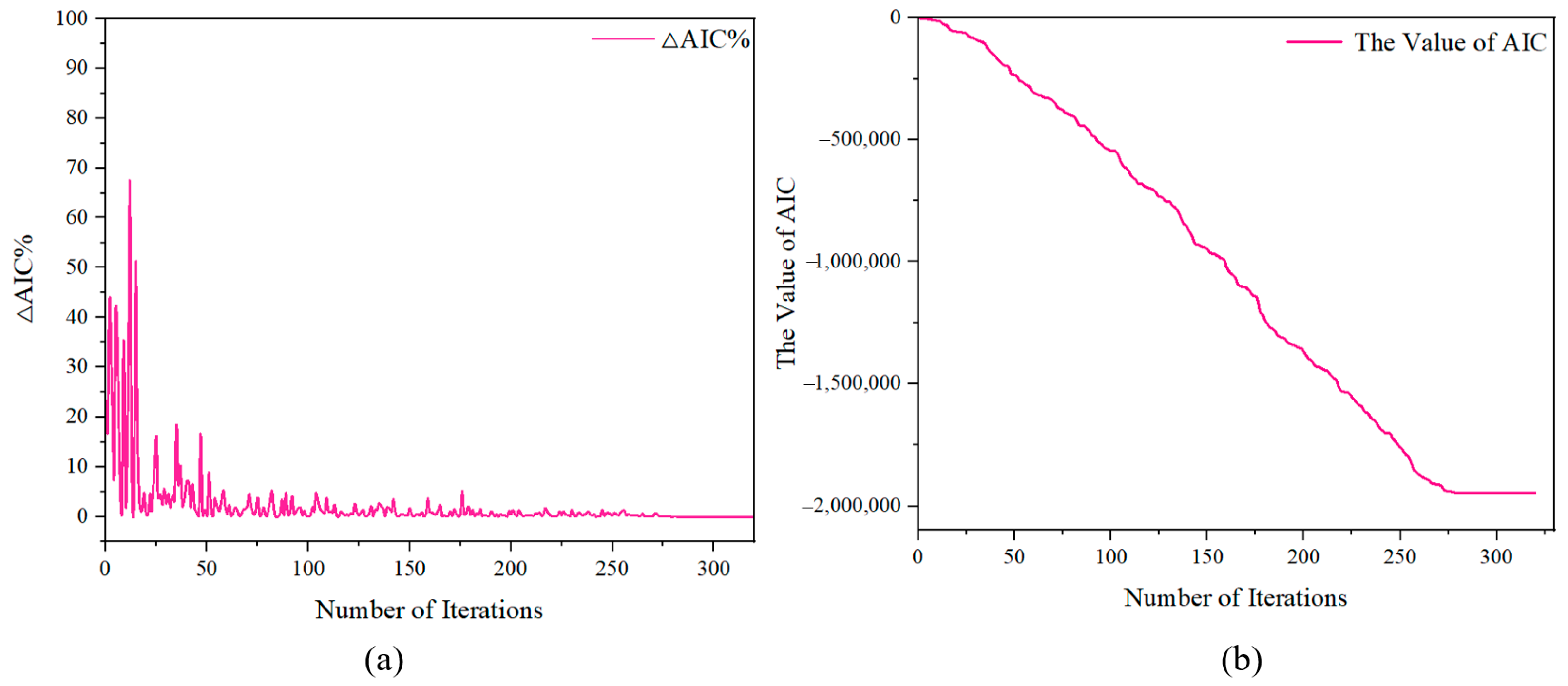
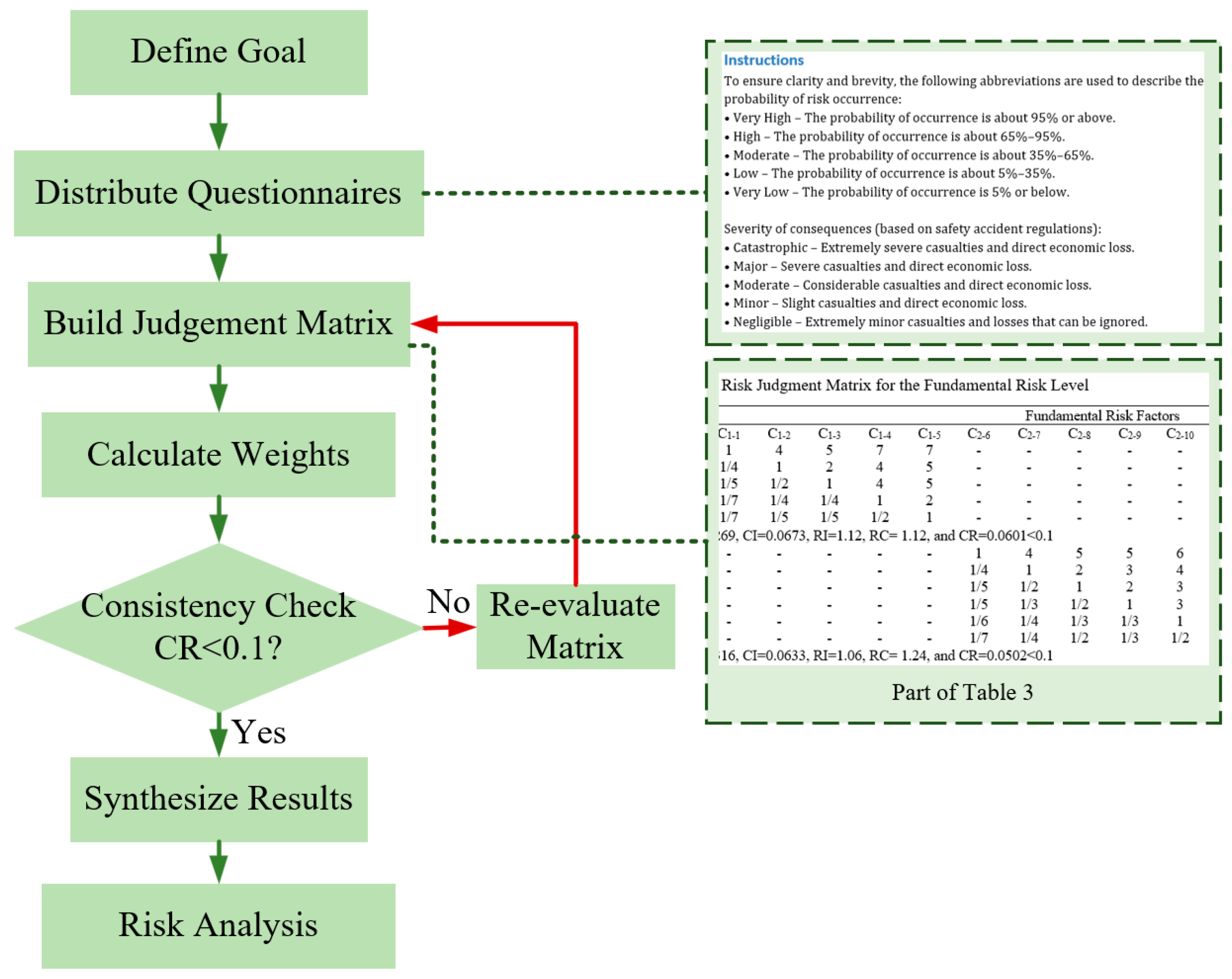
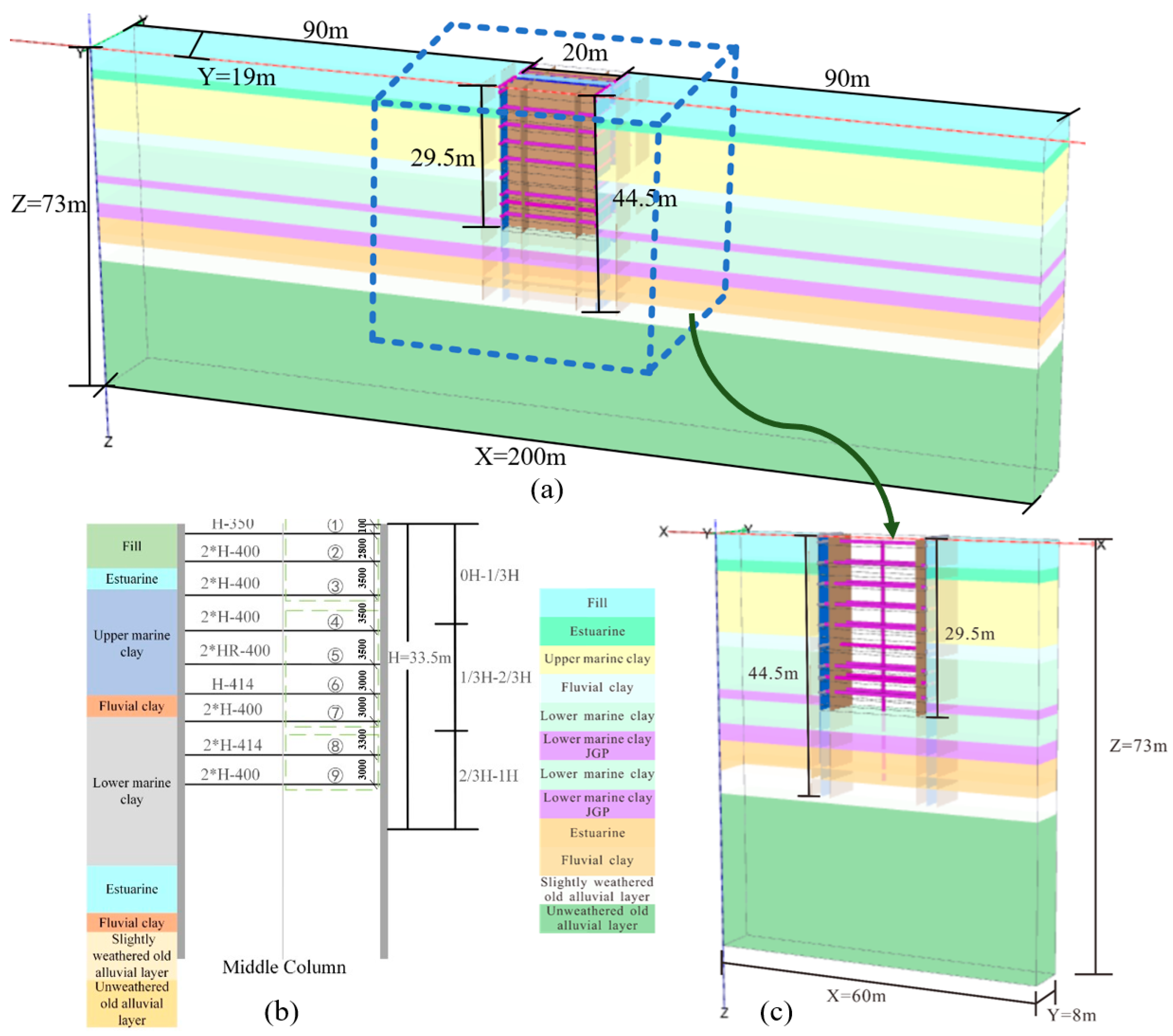
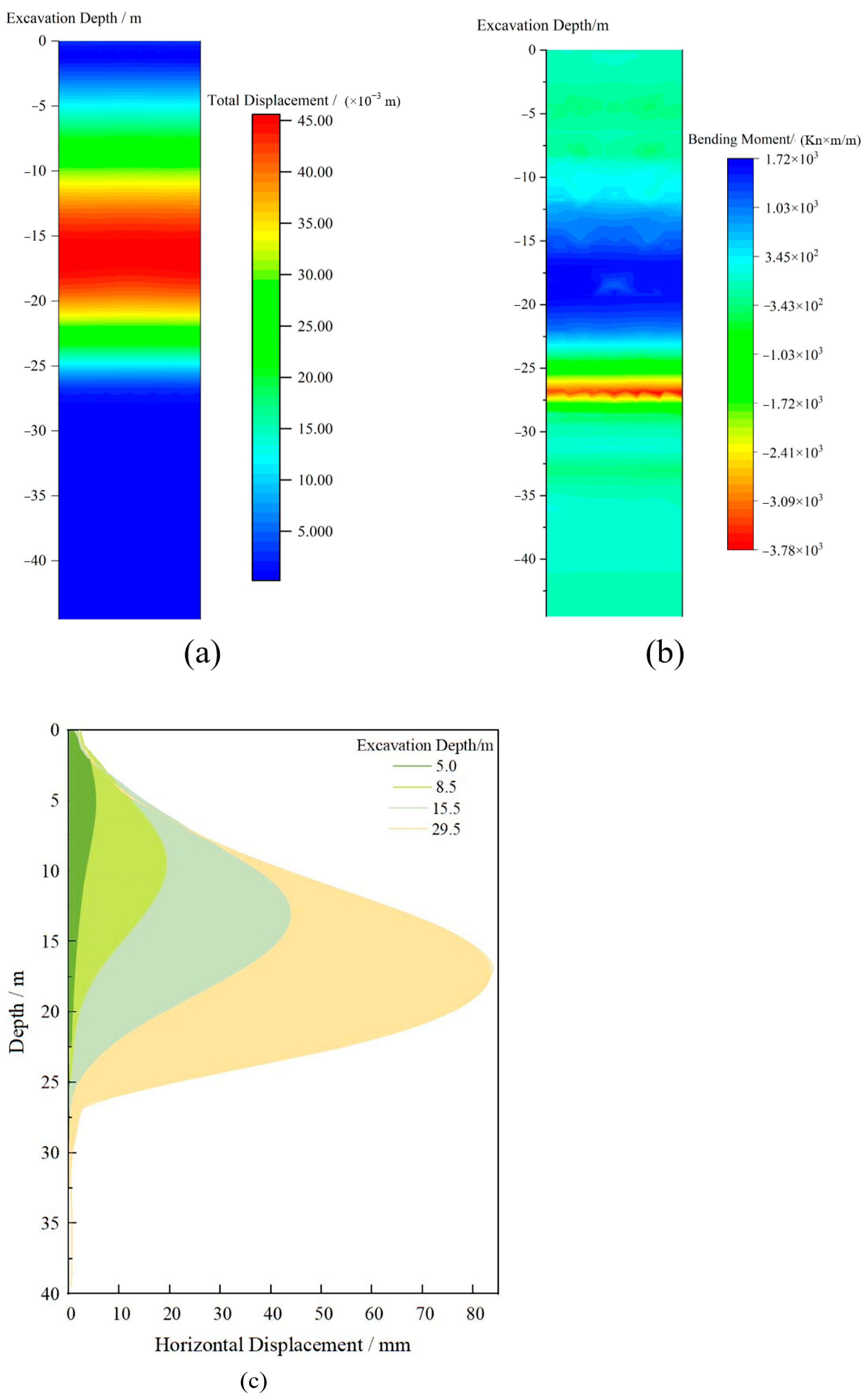

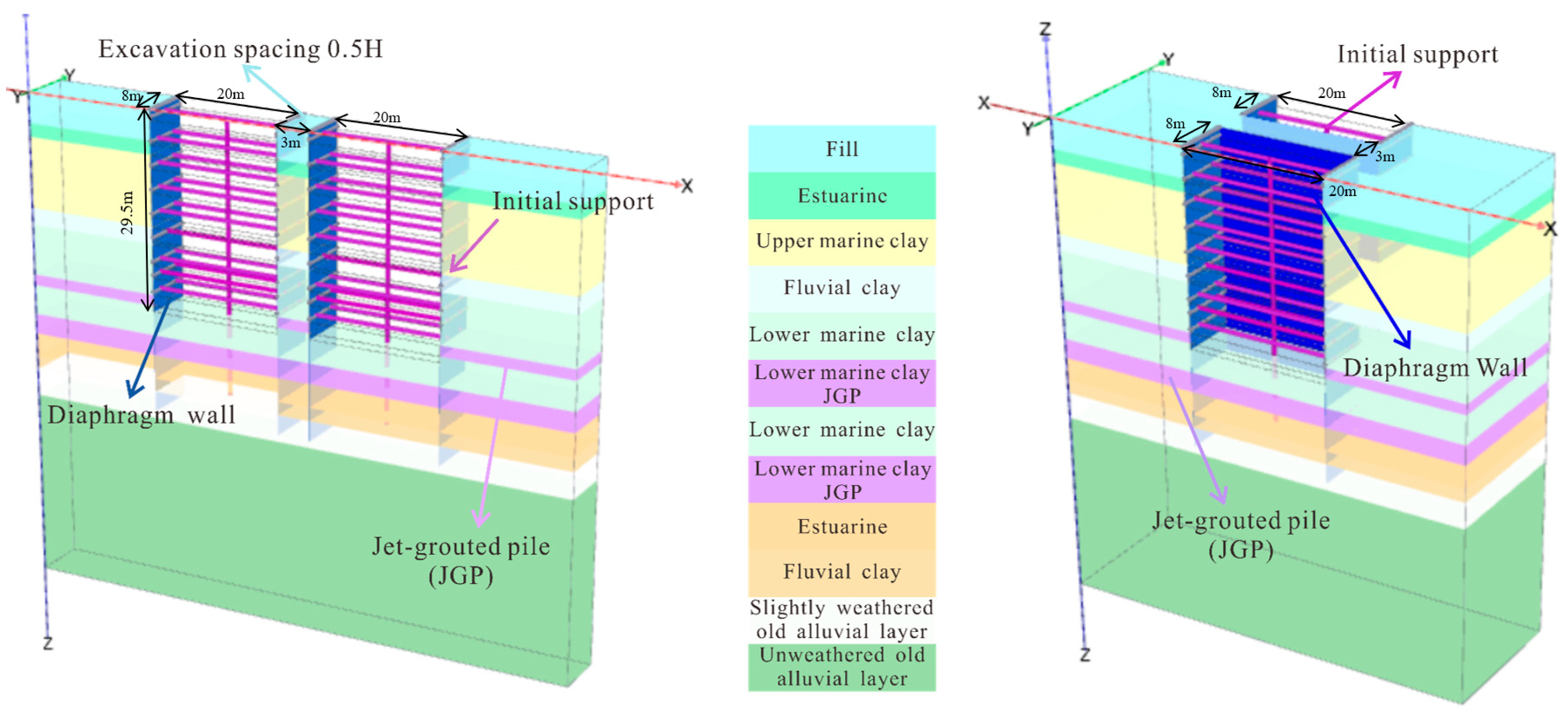
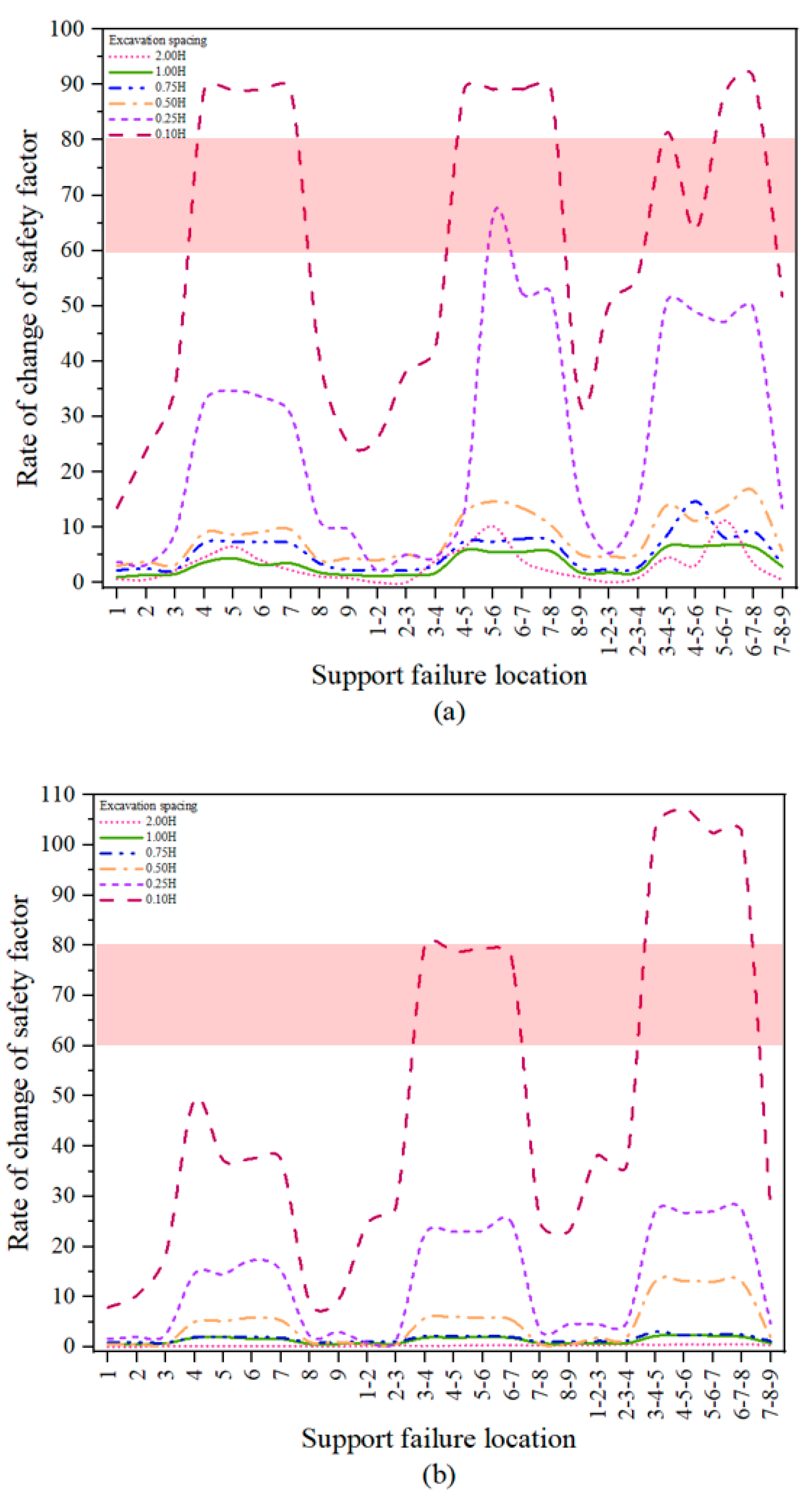
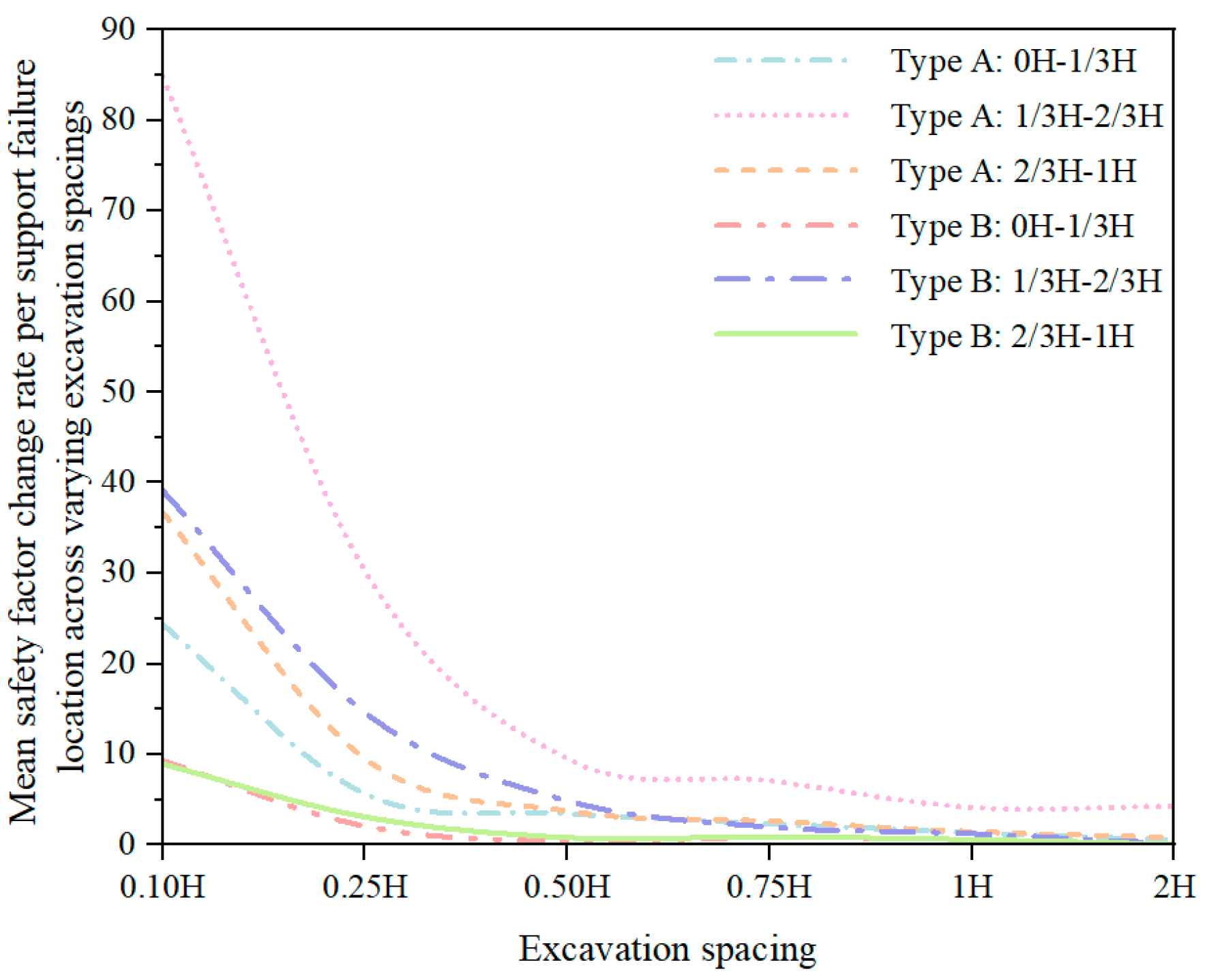
| Top-Level Risk | Second-Level Risk | Third-Level Risk | ||
|---|---|---|---|---|
| Subpit Risk Components | Fundamental Risk | |||
| A: Continuous collapse of DFPCs | B1: Subpit risks | C1: Engineering geological and hydrogeological condition risks | C1-1: Seepage at the bottom of the foundation pit; | |
| C1-2: Leakage through the sidewalls of the foundation pit; | ||||
| C1-3: Improper treatment of weak geological strata; | ||||
| C1-4: Locally weak interlayers within the soil mass; | ||||
| C1-5: Local voids uniformly distributed within the strata. | ||||
| C2: Support structure risks | C2-6: Insufficient anchorage strength of soil nail walls; | |||
| C2-7: Partial failure (fracture) of support piles; | ||||
| C2-8: Failure of supports; | At 0H~1/3H | |||
| At 1/3H~2/3H | ||||
| At 2/3H~1H | ||||
| C2-9: Inadequate embedding depth of brace-type anchors; | ||||
| C2-10: Excessive excavation speed; | ||||
| C2-11: Improper treatment of diaphragm walls. | ||||
| B2: Foundation pit areas and vicinity foundation pits risks | C3: Subsidence of surrounding main roads; | |||
| C4: Excessive localized surcharge loading; | ||||
| C5: Damage to surrounding buildings; | ||||
| C6: Damage to utility pipelines; | ||||
| C7: Excavation spacing among subpits within the DFPC; | 0.25H | |||
| 0.50H | ||||
| 1.00H | ||||
| 2.00H | ||||
| C8: Dynamic loads around the foundation pits. | ||||
| Age Cohort | Information About the Experts | Count |
|---|---|---|
| 25–29 years | Title: PhD students (6) Research Domains:
| 6 |
| 30–39 years | Titles: Senior engineers (8), assistant professors (4), and project directors (3) Research Domains:
| 15 |
| 40–49 years | Titles: Professors (6), chief engineers (5), and technical committee chairs (3) Research Domains:
| 14 |
| 50–59 years | Titles: Chief scientists (4), state council experts (3), and national engineering masters (3) Research Domains:
| 9 |
| Total | 44 | |
| Fundamental Risk Factors | Weight | |||||||||||||||||
|---|---|---|---|---|---|---|---|---|---|---|---|---|---|---|---|---|---|---|
| C1-1 | C1-2 | C1-3 | C1-4 | C1-5 | C2-6 | C2-7 | C2-8 | C2-9 | C2-10 | C2-11 | C3 | C4 | C5 | C6 | C7 | C8 | W | |
| C1-1 | 1 | 4 | 5 | 7 | 7 | - | - | - | - | - | - | - | - | - | - | - | - | 0.5318 |
| C1-2 | 1/4 | 1 | 2 | 4 | 5 | - | - | - | - | - | - | - | - | - | - | - | - | 0.2126 |
| C1-3 | 1/5 | 1/2 | 1 | 4 | 5 | - | - | - | - | - | - | - | - | - | - | - | - | 0.1541 |
| C1-4 | 1/7 | 1/4 | 1/4 | 1 | 2 | - | - | - | - | - | - | - | - | - | - | - | - | 0.0600 |
| C1-5 | 1/7 | 1/5 | 1/5 | 1/2 | 1 | - | - | - | - | - | - | - | - | - | - | - | - | 0.0416 |
| λmax = 5.269, CI = 0.0673, RI = 1.12, RC = 1.12, and CR = 0.0601 < 0.1 | ||||||||||||||||||
| C2-6 | - | - | - | - | - | 1 | 4 | 5 | 5 | 6 | 7 | - | - | - | - | - | - | 0.4781 |
| C2-7 | - | - | - | - | - | 1/4 | 1 | 2 | 3 | 4 | 4 | - | - | - | - | - | - | 0.2022 |
| C2-8 | - | - | - | - | - | 1/5 | 1/2 | 1 | 2 | 3 | 2 | - | - | - | - | - | - | 0.1227 |
| C2-9 | - | - | - | - | - | 1/5 | 1/3 | 1/2 | 1 | 3 | 3 | - | - | - | - | - | - | 0.0974 |
| C2-10 | - | - | - | - | - | 1/6 | 1/4 | 1/3 | 1/3 | 1 | 2 | - | - | - | - | - | - | 0.0545 |
| C2-11 | - | - | - | - | - | 1/7 | 1/4 | 1/2 | 1/3 | 1/2 | 1 | - | - | - | - | - | - | 0.0454 |
| λmax = 6.316, CI = 0.0633, RI = 1.06, RC = 1.24, and CR = 0.0502 < 0.1 | ||||||||||||||||||
| C3 | - | - | - | - | - | - | - | - | - | - | - | 1 | 2 | 3 | 3 | 3 | 8 | 0.3668 |
| C4 | - | - | - | - | - | - | - | - | - | - | - | 1/2 | 1 | 2 | 3 | 3 | 4 | 0.2424 |
| C5 | - | - | - | - | - | - | - | - | - | - | - | 1/3 | 1/2 | 1 | 2 | 2 | 3 | 0.1497 |
| C6 | - | - | - | - | - | - | - | - | - | - | - | 1/3 | 1/3 | 1/2 | 1 | 1 | 3 | 0.0990 |
| C7 | - | - | - | - | - | - | - | - | - | - | - | 1/3 | 1/3 | 1/2 | 1 | 1 | 3 | 0.0990 |
| C8 | - | - | - | - | - | - | - | - | - | - | - | 1/8 | 1/4 | 1/3 | 1/3 | 1/3 | 1 | 0.3240 |
| λmax = 6.1300, CI = 0.0260, RI = 1.26, RC = 1.24, and CR = 0.0206 < 0.1 | ||||||||||||||||||
| Risk Factors at the Fundamental Level | Weight | |||||||
|---|---|---|---|---|---|---|---|---|
| Failure of supports | DFPC spacing | W | ||||||
| 0H~1/3H * | 1/3H~2/3H | 2/3H~1H | 0.25H ** | 0.50H | 1.00H | 2.00H | ||
| 0H~1/3H | 1 | 1/4 | 5 | - | - | - | - | 0.2370 |
| 1/3H~2/3H | 4 | 1 | 8 | - | - | - | - | 0.6986 |
| 2/3H~1H | 1/5 | 1/8 | 1 | - | - | - | - | 0.0643 |
| λmax = 3.0940, CI = 0.0470, RI = 0.58, RC = 0.58, and CR = 0.0811 < 0.1 | ||||||||
| 0.25H | - | - | - | 1 | 6 | 4 | 7 | 0.6065 |
| 0.50H | - | - | - | 1/6 | 1 | 1/2 | 5 | 0.1354 |
| 1.00H | - | - | - | 1/4 | 2 | 1 | 5 | 0.2118 |
| 2.00H | - | - | - | 1/7 | 1/5 | 1/5 | 1 | 0.0463 |
| λmax = 4.2419, CI = 0.0807, RI = 0.9, RC = 0.90, and CR = 0.0896 < 0.1 | ||||||||
| Top-Level Risk | Joint Probability | Second-Level Risk | Joint Probability | Third-Level Risk | |||||
|---|---|---|---|---|---|---|---|---|---|
| Subpit Risk Components | Joint Probability | Fundamental Risk | Joint Probability | Risk Factors | Probability of Occurrence | ||||
| A | 1.40% (1) 98.60% (0) | B1 | 5.99% (1) 94.01% (0) | C2 | 0.73% (1) * 99.27% (0) | C2-6 | - | - | 52.19% (0) |
| C2-7 | - | - | 79.79% (0) | ||||||
| C2-8 | 5.99% (1) 94.01% (0) | At 0H~1/3H | 97.09% (0) | ||||||
| At 1/3H~2/3H | 8.57% (1) | ||||||||
| At 2/3H~1H | 99.21% (0) | ||||||||
| C2-9 | - | - | 90.26% (0) | ||||||
| C2-10 | - | - | 94.55% (0) | ||||||
| C2-11 | - | - | 95.49% (0) | ||||||
| B2 | 0.036% (1) 99.964% (0) | - | - | C3 | - | - | 63.32% (0) | ||
| C4 | - | - | 75.76% (0) | ||||||
| C5 | - | - | 85.03% (0) | ||||||
| C6 | - | - | 90.10% (0) | ||||||
| C7 | 0.36% (1) 99.64% (0) | 0.25H | 6.00% (1) | ||||||
| 0.5H | 98.66% (0) | ||||||||
| 1.0H | 97.90% (0) | ||||||||
| 2.0H | 99.54% (0) | ||||||||
| C8 | - | - | 95.68% (0) | ||||||
| Soil Layer | Depth (m) | γ (kN m−3) Weight | * (°) | c′ * (kPa) | * (MPa) | * (MPa) | * (MPa) |
|---|---|---|---|---|---|---|---|
| Fill | −4.5 | 19 | 30 | 0 | 10.0 | 6.7 | 50.0 |
| Estuarine | −6.5 | 15 | 18 | 0 | 6.0 | 4.0 | 30.0 |
| Upper marine clay | −17.0 | 16 | 22 | 0 | 8.0 | 5.3 | 40.0 |
| Fluvial clay | −19.5 | 19 | 22 | 0 | 8.0 | 5.3 | 40.0 |
| Lower marine clay | −34.5 | 16 | 24 | 0 | 16.0 | 10.7 | 80.0 |
| Estuarine | −39.5 | 15 | 18 | 0 | 25.0 | 16.7 | 125.0 |
| Fluvial clay | −41.5 | 19 | 22 | 0 | 10.4 | 6.9 | 51.7 |
| Slightly weathered old alluvial layer | −45.5 | 20 | 32 | 5 | 46.5 | 31.0 | 232.5 |
| Unweathered old alluvial layer | −73.0 | 20 | 33 | 5 | 61.0 | 40.7 | 305.0 |
| Diaphragm Wall | = 0.2 | ||||
|---|---|---|---|---|---|
| E (kPa) | 3.25 × 107 | Strut type | H-350 | H-400 | H-414 |
| ν | 0.2 | Ix (cm4) | 39,800 | 66,600 | 92,800 |
| Thickness (m) | 0.8 | Iy (cm4) | 13,600 | 22,400 | 31,000 |
| γ (kN m−1) | 25 | A (cm2) | 171.9 | 218.7 | 295.4 |
| Step | Description |
|---|---|
| a. | Perform initial geostatic stress balance. |
| b. | Construct the diaphragm walls and the jet grouting reinforcement layer. |
| c. | Lower the groundwater level to 1 m below the current excavation level. Then, excavate the first layer and install the first level of struts at 0.5 m above the excavation surface. |
| d. | Repeat the procedure described in step c for excavating and installing struts for layers 2 to 9. |
| e. | Lower the groundwater level to 1 m below the 10th excavation level. Excavate the 10th layer without strut installation. The final excavation depth reaches 29.5 m, which is defined in this study as the final excavation depth. |
| Maximum Moment (N∙m∙m−1) | Horizontal Displacements at Different Depths (mm) | ||||
|---|---|---|---|---|---|
| Positive | Negative | 8.5 m | 22.5 m | 29.5 m | |
| Proposed model | 1.72 × 106 | −3.78 × 106 | 18.59 | 55.24 | 83.86 |
| Zheng’s model [35] | 2.29 × 106 | −3.45 × 106 | 20 | 60 | 90 |
| Discrepancy | 24.89% | 9.57% | 7.05% | 7.93% | 6.82% |
Disclaimer/Publisher’s Note: The statements, opinions and data contained in all publications are solely those of the individual author(s) and contributor(s) and not of MDPI and/or the editor(s). MDPI and/or the editor(s) disclaim responsibility for any injury to people or property resulting from any ideas, methods, instructions or products referred to in the content. |
© 2025 by the authors. Licensee MDPI, Basel, Switzerland. This article is an open access article distributed under the terms and conditions of the Creative Commons Attribution (CC BY) license (https://creativecommons.org/licenses/by/4.0/).
Share and Cite
Huang, C.; Zheng, Z.; Li, Y.; Li, W. Integrating Bayesian Networks and Numerical Simulation for Risk Assessment of Deep Foundation Pit Clusters. Buildings 2025, 15, 3355. https://doi.org/10.3390/buildings15183355
Huang C, Zheng Z, Li Y, Li W. Integrating Bayesian Networks and Numerical Simulation for Risk Assessment of Deep Foundation Pit Clusters. Buildings. 2025; 15(18):3355. https://doi.org/10.3390/buildings15183355
Chicago/Turabian StyleHuang, Chun, Zixin Zheng, Yanlin Li, and Wenjie Li. 2025. "Integrating Bayesian Networks and Numerical Simulation for Risk Assessment of Deep Foundation Pit Clusters" Buildings 15, no. 18: 3355. https://doi.org/10.3390/buildings15183355
APA StyleHuang, C., Zheng, Z., Li, Y., & Li, W. (2025). Integrating Bayesian Networks and Numerical Simulation for Risk Assessment of Deep Foundation Pit Clusters. Buildings, 15(18), 3355. https://doi.org/10.3390/buildings15183355






